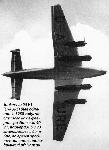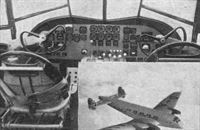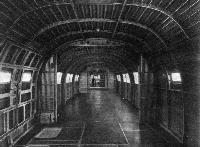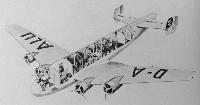
Описание
Страна : Германия
Год : 1937
Four-engined forty-passenger commercial monoplane
Варианты
Junkers Ju 90, 290 и 390
По состоянию на 1936 год в компании "Junkers" в разной стадии постройки находились три опытных образца четырехмоторного бомбардировщика Ju 89. В 1937 году, вскоре после полета первого прототипа, программа была закрыта, и специалисты компании разработали гражданский вариант Ju 90. Были построены четыре опытных образца авиалайнера. Следом были построены 10 предсерийных самолетов Ju 90B-1, представлявших собой 38-40-местные лайнеры. Восемь из них поступили в авиакомпанию "Luft-Hansa", а два были проданы компании "South African Airways", но поставлены так и не были.
<...>
Описание:
- Junkers Ju 90, 290 и 390
- Flight, September 1937
JUNKERS' NINETIETH
Фотографии
-
Aeroplane Monthly 1988-09 / J.Stroud - Wings of Peace
Регистрационный номер: D-AALU [7] Ju 90 V1 имел новый фюзеляж, совмещенный с крылом, силовой установкой (двигатели Daimler Benz DB 600) и хвостовым оперением третьего прототипа не пошедшего в серию бомбардировщика Ju 89. Позже самолеты оснащались двигателями BMW 732 или BMW801.
The prototype Junkers Ju 90V1 was D-AALU Der Grosse Dessaur, powered by four Daimler-Benz DB600 engines. The Junkers “double wing” elevators are clearly visible. It first flew on June 7, 1937, but broke up in flight on February 6, 1938, during flutter tests. -
Flight 1937-12 / Flight Advertisements
Регистрационный номер: D-AALU [7] -
Jane's All the World Aircraft 1938 / 03 - All the world's aeroplanes
Регистрационный номер: D-AALU [7] The Junkers Ju.90 Four-engined Commercial Monoplane (four Junkers "Jumo 205" hevay-oil engines).
-
Aeroplane Monthly 1988-09 / J.Stroud - Wings of Peace
Регистрационный номер: D-AALU [7] Two views of the Ju 90 V1 showing engine installation, wing planform and window arrangement.
-
Aeroplane Monthly 1988-09 / J.Stroud - Wings of Peace
Регистрационный номер: D-AALU [7] The Junkers-Ju 90V1 D-AALU Der Grosse Dessauer, with Daimler-Benz DB 600A liquid-cooled engines.
-
Flight 1937-09 / Flight
Регистрационный номер: D-AALU [7] 'THE DESSAU GIANT' is a free translation of the name of the prototype Junkers Ju.90. The installation of the inverted-vee Mercedes can be gathered from this view
-
Jane's All the World Aircraft 1980 / Encyclopedia of Aviation - Aircraft A-Z - v4
Регистрационный номер: D-AURE [4] Junkers Ju 90.
-
Aeroplane Monthly 1988-09 / J.Stroud - Wings of Peace
Регистрационный номер: D-ABDG [2] D-ABDG Wurttemberg, the first production Ju 90B-1. The “double-wing” flaps and ailerons can be seen clearly and the double entrance doors are visible.
-
Aeroplane Monthly 1988-09 / J.Stroud - Wings of Peace
Регистрационный номер: D-ADFJ [2] D-ADFJ Baden, the Ju 90V7, at Croydon on August 14, 1939.
-
Flight 1939-08 / Flight
Регистрационный номер: D-ADFJ [2] ANGLE 2: Due to the perspective it is difficult to reconcile this view of the Ju.90 with that shown above. It shows among other things, the Junkers so-called “double-wing” arrangement.
-
Aeroplane Monthly 1988-09 / J.Stroud - Wings of Peace
Регистрационный номер: D-AURE [4] RAPID REPLACEMENT: The firm of Junkers, in co-operation with the German engine manufacturers and D.L.H., are endeavouring to standardise engines, accessories and mountings so that they can be rapidly replaced when necessary. With the Junkers Ju.90, for instance, tests have recently been made to show that individual engines can be replaced in twenty minutes by three ground engineers and a mobile crane. At a demonstration the machine landed, had the engine changed, and was in the air again within the half-hour - a time so short that it would not cause a delay of more than a few minutes at any stopping-point on an air service.
D-AURE Bayern at Tempelhof, showing the removal of an engine as a complete powerplant. An engine could be changed in 25min. The folding forward door is visible. -
Flight 1939-03 / Flight
Регистрационный номер: D-AIVI [3] -
Aeroplane Monthly 1988-09 / J.Stroud - Wings of Peace
Регистрационный номер: D-AIVI [3] An impressive view of D-AIVI after receiving its fuselage styling.
-
Flight 1939-08 / Flight
Регистрационный номер: D-ASND IN SERVICE: The first Junkers Ju.90 to be seen in this country arrived on the normal Berlin-London run on August 1. The impressive size of this forty-seater is shown by the relative smallness of the Marcel Bloch on the right. The “accident” on the left is merely a group of Imperial machines, including two Frobisher-class and one Ensign-class liner. The Ju.90’s tail unit is interestingly complicated.
Другие самолёты на фотографии: Armstrong Whitworth Ensign / A.W.27 - Великобритания - 1938Bloch MB.220 - Франция - 1936De Havilland Albatross / D.H.91 - Великобритания - 1937
-
Aeroplane Monthly 1979-03 / R.Williams - Ensigns for the Empire (1)
Croydon scene just before the war. In this view are the A.W.27s Ettrick, Elysian, Elsinore, Eddystone and Explorer, the D.H.91s Frobisher and Falcon, the H.P.45 Horatius and the Short L.17 Syrinx. Just visible in the background is a Junkers-Ju 90.
Imperial Airways airliners grounded at Croydon during the last month of peace had to stand in the open. Behind G-ADSX Ettrick can be seen G-ADSZ Elysian and G-ADST Elsinore.Другие самолёты на фотографии: Armstrong Whitworth Ensign / A.W.27 - Великобритания - 1938De Havilland Albatross / D.H.91 - Великобритания - 1937Handley Page H.P.42 / H.P.45 - Великобритания - 1930Short Scylla / L.17 - Великобритания - 1934
-
Air Enthusiast 1999-07 / G.Cruz - Singular Giant
Регистрационный номер: D-ADLH Before the Ju 290s, the DLH were already using some Ju 90s, like D-ADLH ‘Sachsen’, seen here soon after taking off from Palma de Mallorca in the early 1940s. The Ju 52/3m in the foreground was one of four purchased by Iberia in early 1941.
Другие самолёты на фотографии: Junkers Ju.52/3m - Германия - 1931
-
Flight 1939-04 / Flight
FOUR-ENGINED FASHIONS: the Junkers Ju 90
-
Aeroplane Monthly 1988-09 / J.Stroud - Wings of Peace
Регистрационный номер: D-AURE [4] The Ju 90V3 D-AURE Bayern was the first Ju 90 to operate passenger services - between Berlin and Vienna.
-
Мировая Авиация 206
Ju 90 имел рампу Trapoklappe с гидроприводом - полностью выпущенная, она поднимала хвостовую часть самолета, что позволяло подогнать под него машину для загрузки с кузова (по ней же машины могли заезжать в кабину). Рампа могла также выпускаться в полете для осуществления десантирования - как на этом Ju 90 V7.
-
Aeroplane Monthly 1985-08 / B.Johnson - Flugkapitan Hanna Reitsch. 1914-1979 (3)
A dramatic shot of an Me 321 Gigant being towed into the air by a Junkers Ju 90 at Leipheim.
Другие самолёты на фотографии: Messerschmitt Me.321 Gigant - Германия - 1941
-
Aeroplane Monthly 1977-06 / B.Gunston - Gigant
A Me 321, towed by a Ju 90, fades away behind its own murk at Leipheim. The 321 has yet to jettison its front wheels, but the main wheels have already gone.
Другие самолёты на фотографии: Messerschmitt Me.321 Gigant - Германия - 1941
-
Air Enthusiast 1971-08 / In print
An illustration from Volume IV of “Dora Kurfurst und rote 13" showing a Junkers Ju 90 prototype taking off at Obertraubling in June 1941 with a Messerschmitt Me 321 glider in tow. The latter has four underwing rocket packs to assist the take-off.
Другие самолёты на фотографии: Messerschmitt Me.321 Gigant - Германия - 1941
-
Авиация и Время 2007-01 / К.Кузнецов - Тряпичный "Гигант" люфтваффе
Взлет Me 321 с использованием ракетных ускорителей. Вверху - планер буксирует Ju 90, внизу - "Тройка"
Другие самолёты на фотографии: Messerschmitt Bf.110 - Германия - 1936Messerschmitt Me.321 Gigant - Германия - 1941
-
Мировая Авиация 163
Регистрационный номер: D-AURE [4] Junkers Ju 90 V3 (D-AURE) был облетан в 1938 году, после того как в феврале разбился Ju 90 V1. Карьера Ju 90 V3 завершилась в декабре, во время пробных полетов, проводимых "Luft Hansa".
JU.90 ANGLE 1: A unique study of the big four-engined Junkers Ju.90 transport, which is often to be seen at Croydon, showing the unusual shape of the wing. -
Aeroplane Monthly 1988-09 / J.Stroud - Wings of Peace
Один из первых Ju 90B-1, принадлежавший 290-й транспортной эскадрилье, попал под огонь британских истребителей над Средиземным морем. Хорошо видно впервые примененное крыло и характерные закрылки фирмы "Junkers".
An unidentified Ju 90 under attack off Corsica. It is likely that it was destroyed. -
Jane's All the World Aircraft 1980 / Encyclopedia of Aviation - Aircraft A-Z - v4
Junkers Ju 90 fuselage under construction.
-
Aeroplane Monthly 1988-09 / J.Stroud - Wings of Peace
Регистрационный номер: D-AIVI [3] A view taken at Dessau in the spring of 1938 showing D-AIVI, the Ju 90V2, under construction. This was the first example with radial engines; like D-AALU it was lost during testing, this time at Bathurst in the Gambia in November 26, 1938.
-
Flight 1938-05 / Flight Advertisements
Junkers Ju.90 equipped with Askania-Aircraft-Instruments.
-
Aeroplane Monthly 1988-09 / J.Stroud - Wings of Peace
One of the eight-seat smoking cabins in the Ju 90.
-
Jane's All the World Aircraft 1980 / Encyclopedia of Aviation - Aircraft A-Z - v4
Interior of a Junkers Ju 90.
-
Flight 1937-09 / Flight
"THESE COMMODIOUS UNFURNISHED PREMISES." The house-agents' jargon seems nicely applicable to the truly startling interior of the prototype Junkers Ju.90 airliner, which is now undergoing its initial flying trials. Divided into five compartments, the cabin will accomodate forty passengers, and there will be several baggage, mail and lavatory divisions.
The unobstructed interior, looking forward. -
Aeroplane Monthly 1988-09 / J.Stroud - Wings of Peace
Регистрационный номер: D-ABDG [2] KEITH WOODCOCK’S painting shows the Junkers-Ju 90B-1 D-ABDG Wurttemberg, the first production aeroplane.
-
Jane's All the World Aircraft 1938 / 03 - All the world's aeroplanes
Регистрационный номер: D-AALU [7] A drawing of the Junkers Ju.90 wich shows the arrangement of the passenger accomodation.
- Фотографии

































